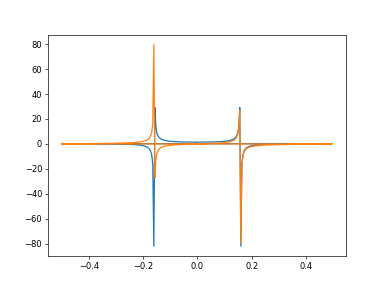nlcpy.fft.fft
- nlcpy.fft.fft(a, n=None, axis=- 1, norm=None)[source]
Computes the one-dimensional discrete fourier transform.
This function computes the one-dimensional n-point discrete fourier transform (DFT) with the efficient fast fourier transform (FFT) algorithm.
- Parameters
- aarray_like
Input array, can be complex.
- nint,optional
Length of the transformed axis of the output. If n is smaller than the length of the input, the input is cropped. If it is larger, the input is padded with zeros. If n is not given, the length of the input along the axis specified by axis is used.
- axisint,optional
Axis over which to compute the FFT. If not given, the last axis is used. If axis is larger than the last axis of a, IndexError occurs.
- norm{None, “ortho”},optional
Normalization mode. By default(None), the transforms are unscaled. It norm is set to “ortho”, the return values will be scaled by
.
- Returns
- outcomplex ndarray
The truncated or zero-padded input, transformed along the axis indicated by axis , or the last one if axis is not specified.
See also
ifftComputes the one-dimensional inverse discrete fourier transform.
fft2Computes the 2-dimensional discrete fourier transform.
fftnComputes the n-dimensional discrete fourier transform.
rfftnComputes the n-dimensional discrete fourier transform for a real array.
fftfreqReturns the discrete fourier transform sample frequencies.
Note
FFT (fast fourier transform) refers to a way the discrete fourier transform (DFT) can be calculated efficiently, by using symmetries in the calculated terms. The symmetry is highest when n is a power of 2, and the transform is therefore most efficient for these sizes.
Examples
>>> import nlcpy as vp >>> vp.fft.fft(vp.exp(2j * vp.pi * vp.arange(8) / 8)) array([-3.44509285e-16+1.14423775e-17j, 8.00000000e+00-8.52069395e-16j, 2.33486982e-16+1.22464680e-16j, 0.00000000e+00+1.22464680e-16j, 9.95799250e-17+2.33486982e-16j, 0.00000000e+00+1.17281316e-16j, 1.14423775e-17+1.22464680e-16j, 0.00000000e+00+1.22464680e-16j])
In this example, real input has an FFT which is Hermitian, i.e., symmetric in the real part and anti-symmetric in the imaginary part:
>>> import matplotlib.pyplot as plt >>> t = vp.arange(256) >>> sp = vp.fft.fft(vp.sin(t)) >>> freq = vp.fft.fftfreq(t.shape[-1]) >>> _ = plt.plot(freq, sp.real, freq, sp.imag) >>> plt.show()
